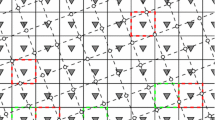Abstract
We prove the following: Given four (or more) orthographic views of three points then (a) the views almost surely have no rigid interpretation but (b) if they do then they almost surely have at most thirty-two rigid interpretations. Part (a) means that the measure of “false targets”, viz., the measure of nonrigid motions that project to views having rigid interpretations, is zero. Part (b) means that rigid interpretations, when they exist, are not unique. Uniqueness of interpretation can be obtained if a point is added, but not if views are added. Our proof relies on an upper semicontinuity theorem for proper mappings of complex algebraic varieties. We note some psychophysical motivations of the theory.
Similar content being viewed by others
References
J. Aloimonos and A. Bandyopadhyay, “Perception of structure from motion: lower bound results,”Univ. of Rochester Dept. of Comput. Sci. TR 158, 1985.
B.M. Bennett and D.D. Hoffman, “The computation of structure from fixed-axis motion: nonrigid structures,”Biol. Cybern., 51, pp. 293–300, 1985.
B.M. Bennett, D.D. Hoffman, J.S. Kim, and S.N. Richman, “Inferring 3D structure from image motion: The constraint of Poinsot motion”J. Math. Imaging Vis., (in press).
B.M. Bennett, D.D. Hoffman, J.E. Nicola, and C. Prakash, “Structure from two orthographic views of rigid motion,”J. Opt. Soc. Am. A, 6 pp. 1052–1069, 1989.
E.H. Carlton and R.N. Shepard, “Psychologically simple motions as geodesic paths: I. Asymmetric objects,”J. Math. Psych., 34 pp. 127–188, 1990.
E. H. Carlton and R. N. Shepard, “Psychologically simple motions as geodesic paths: II. Symmetric objects,”J. Math. Psych., 34, pp. 189–228, 1990.
O.D. Faugeras and S. Maybank, “Motion from point matches: Multiplicity of solutions,”Inter. J. Comput. Vis., 4 pp. 225–246, 1990.
N. Grzywacz and E. Hildreth, “Incremental rigidity scheme for recovering structure from motion: Position-based versus velocity-based formulations,”J. Opt. Soc. Am. A, 4, pp. 503–518, 1987.
D.D. Hoffman and B.M. Bennett, “Inferring the relative three-dimensional positions of two moving points,”J. Opt. Soc. Am. A, 2 pp. 350–353, 1985.
D.D. Hoffman and B.M. Bennett, “The computation of structure from fixed-axis motion: rigid structures,”Biol. Cybern., 54 71–83, 1986.
D.D. Hoffman and B.E. Flinchbaugh, “The interpretation of biological motion,”Biol. Cybern., 42 pp. 197–204, 1982.
T. Huang and C. Lee, “Motion and structure from orthographic projections,”IEEE Trans. Patt. Anal. Mach. Intell., 11, pp. 536–540, 1989.
J. Koenderink and A. van Doorn, “Depth and shape from differential perspective in the presence of bending deformations,”J. Opt. Soc. Am. A, 3 pp. 242–249, 1986.
J. Koenderink and A. van Doorn, “Invariant properties of the motion parallax field due to the movement of rigid bodies relative to an observer,”Optica Acta, 22 pp. 773–791, 1975.
E. Kruppa, “Zur Ermittlung eines Objektes aus zwei Perspektiven mit innerer Orientierung,”Akademie der Wissenschaften in Wien: Mathematisch-naturwissenschaftliche Klasse Sitzungsberichte, 122 pp. 1939–1948, 1913.
H.C. Longuet-Higgins, “A computer algorithm for reconstructing a scene from two perspective projections,”Nature, 293, pp. 133–135, 1981.
S. Ullman,The interpretation of visual motion (MIT Press, Cambridge, Mass., 1979).
A. Waxman and K. Wohn, “Contour evolution, neighborhood deformation, and image flow: Textured surfaces in motion,” inImage Understanding, 1985–1986, W. Richards and S. Ullman, eds. (Ablex, Norwood, New Jersey, 1987), pp. 72–98.
J.A. Webb and J.K. Aggarwal, “Structure from motion of rigid and jointed objects,”Artif. Intell., 19, pp. 107–130, 1982.
M.L. Braunstein, D.D. Hoffman, and F.E. Pollick, “Discriminating rigid from nonrigid motion: Minimum points and views,”Percept. Psychophys., 47, pp. 205–214, 1990.
M. Braunstein, D. Hoffman, L. Shapiro, G. Andersen, and B. Bennett, “Minimum points and views for the recovery of three-dimensional structure,”J. Exper. Psychol.: Human Percept. and Perfor., 13 pp. 335–343, 1987.
J.J. Gibson and E.J. Gibson, “Continuous perspective transformations and the perception of rigid motion,”J. Exper. Psychol. 54 pp. 129–138, 1957.
D.L. Gilden and D.R. Proffitt, “Understanding collision dynamics,”J. Exper. Psychol.: Human Percept Perform., 15 pp. 372–383, 1989.
B. Green, “Figure coherence in the kinetic depth effect,”J. Exper. Psychol., 62 pp. 272–282, 1961.
M.K. Kaiser and D.R. Proffitt, “The development of sensitivity to casually relevant dynamic information,”Child Development, 55 pp. 1614–1624, 1984.
M.K. Kaiser and D.R. Proffitt, “Observers' sensitivity to dynamic anomalies in collisions,”Percept. Psychophys., 42 pp. 275–280, 1987.
J.S. Lappin, J.F. Donner, and B. Kottas, “Minimal conditions for the visual detection of structure and motion in three dimensions,”Science, 209 pp. 717–719, 1980.
D.R. Proffitt, D. Gilden, M.K. Kaiser, and S. Whelan, “The effect of configural orientation on perceived trajectory in apparent motion,”Percept. Psychophys., 45 pp. 465–474, 1988.
V.S. Ramachandran, S. Cobb, and D. Rogers-Ramachandran, “Perception of 3-D structure from motion: The role of velocity gradients and segmentation boundaries,”Percept. Psychophys., 44, pp. 390–393, 1988.
J.T. Todd, R.A. Akerstrom, F.D. Reichel, and W. Hayes, “Apparent rotation in three-dimensional space; Effects of temporal, spatial, and structural factors,”Percept. Psychophys., 43, pp. 179–188, 1988.
J.T. Todd, and W.H. Warren, “Visual perception of relative mass in dynamic events,” Perception, 11, pp. 325–335, 1982.
H. Wallach and D O'Connell, “The kinetic depth effect,”J. Exper. Psychol., 45 pp. 205–217, 1953.
B.M. Bennett, D.D. Hoffman, and C. Prakash,Observer mechanics (Academic Press, New York, 1989.
B.M. Bennett, D.D. Hoffman, and C. Prakash, “Unity of perception,”Cognition, 38 pp. 295–334, 1991.
Author information
Authors and Affiliations
Rights and permissions
About this article
Cite this article
Bennett, B.M., Hoffman, D.D. Inferring 3D structure from three points in rigid motion. J Math Imaging Vis 4, 401–406 (1994). https://doi.org/10.1007/BF01262405
Issue Date:
DOI: https://doi.org/10.1007/BF01262405




